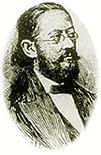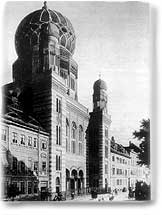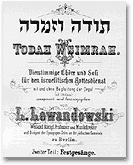|


In the year 1840 in the city of Berlin, the first choir director in the history
of the synagogue was appointed. At the Heiderautergasse Temple, and later
at the new Oranienburgerstrasse Temple, Louis Lewandowski (1821-1894) conducted
the music of his Viennese mentor, the great Cantor Salomon Sulzer, as well
as his own compositions. The music of German synagogues had for centuries
consisted of cantorial recitatives and congregational responses, and Lewandowski's
choral compositions introduced a new and popular type of service.
Louis Lewandowski was born in the Polish town of Wreschen. At the age of twelve,
after his mother's death and because of his family's extreme poverty, he left
for Berlin here he became an apprentice for cantor Asher Lion. Soon the boy's
musical ambition reached out beyond the ghetto. With the help of Alexander
Mendelssohn (cousin of the composer Felix Mendelssohn), Lewandowski became
the first Jew to attend the Berlin Academy of the Arts. But after showing
great promise in the field of secular music (including a prize for composition
from the prestigious Berlin Singakademie), Lewandowski succumbed to a serious
nervous disorder and was forced to relinquish his scholarship and abandon
his studies. It was after his partial recovery that the lad decided to devote
himself fully to the music of the synagogue.
| 
The Oranienburgerstrasse Temple
|
For twenty-four years Lewandowski worked as choirmaster at the
Heidereutergasse Temple in Berlin, conducting the music of Salomon Sulzer.
But in 1864 the building of the Oranienburgerstrasse Temple, which was equipped
with an organ, offered Lewandowski the opportunity of creating an entire new
service with organ accompaniment [back]—[back] a task never
before undertaken. The culmination of his career came in 1882 with the publication
of his magnum opus, Todah ve-Zimrah (Thanks and Song), a setting of
the entire liturgical cycle for four soloists, cantor and organ.
|

|
Lewandowski was among the most significant composers of synagogue
music, reproducing the traditional melodies in a more classical form and giving
freer treatment to the organ music than his distinguished predecessor Cantor
Sulzer had. He exerted a strong influence on Western Ashkenazi synagogal music
through his activities as a teacher at the Jewish Free School and the Jewish
Teachers' Seminary in Berlin. He based his compositions on the liturgical
tradition of the Old Synagogue, on the one hand, and on the East European
tunes he received from immigrant cantors, on the other. His choral settings
following the style of Mendelssohn's oratorios and works for choir. Among
Lewandowski's principal works are Kol Rina u-Tfillah (1871), Todah
ve-Zimrah for four soloists, cantor and organ (1876-1882), and 18 liturgical
Psalms for solo, choir and organ.
|
 Ma
Tovu Ohaleha Yaako "How Goodly are your tents, O Jacob"
from the daily and Sabbath liturgy. Music by Louis Lewandowski, sung
by the Zamir Chorale; Joshua Jacobson, conductor; Dr. Jules Rosenberg,
solo. Ma
Tovu Ohaleha Yaako "How Goodly are your tents, O Jacob"
from the daily and Sabbath liturgy. Music by Louis Lewandowski, sung
by the Zamir Chorale; Joshua Jacobson, conductor; Dr. Jules Rosenberg,
solo.
 Lecha
Dodi — "Come by beloved to meet the [Sabbath] bride"
— from the Friday evening hymn welcoming the Sabbath. Music by Louis
Lewandowski, sung by the Zamir Chorale,
Joshua Jacobson, conductor, Dr. Jules Rosenberg, solo Lecha
Dodi — "Come by beloved to meet the [Sabbath] bride"
— from the Friday evening hymn welcoming the Sabbath. Music by Louis
Lewandowski, sung by the Zamir Chorale,
Joshua Jacobson, conductor, Dr. Jules Rosenberg, solo
If
you don't already have the Real Audio plug-in for your browser, you
can download
the free RealPlayer from Real
Networks in order to hear the broadcast.
|
|
 From:
Zamir Chorale of Boston "The Majesty of Holiness" From:
Zamir Chorale of Boston "The Majesty of Holiness"
Buy the CD |
|
CD-booklet
"The Musical Tradition of the Jewish Reform Congregation in Berlin"produced
by the Feher Jewish Music Center at Beth Hatefutsoth, Museum of the Jewish
Diaspora, Tel Aviv.
Booklet
for accompanying the Zamir Chorale of Boston CD, "The Majesty
of Holiness" (recorded 1985, 1997).
|
CHOIR
Table of Contents
|
|
|
|